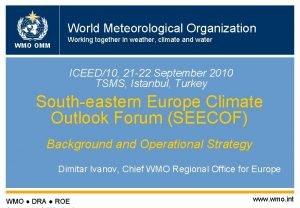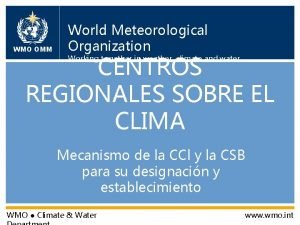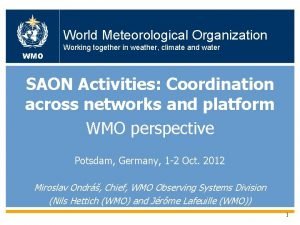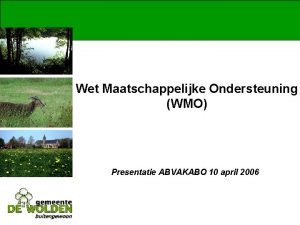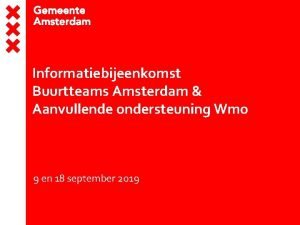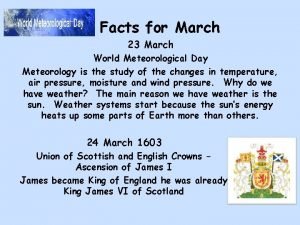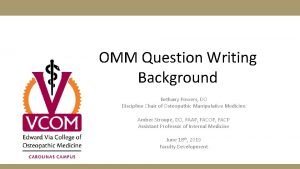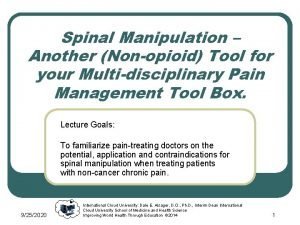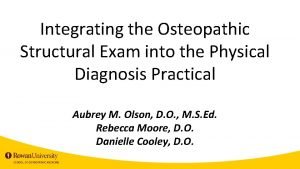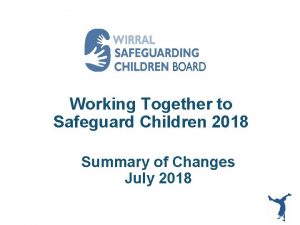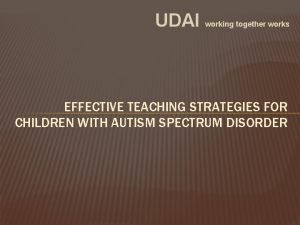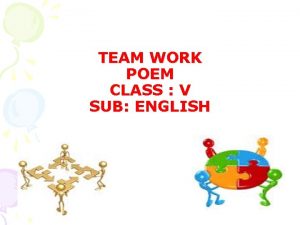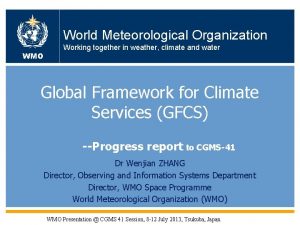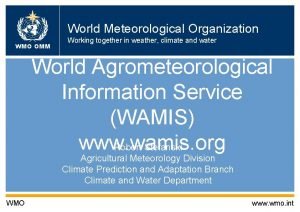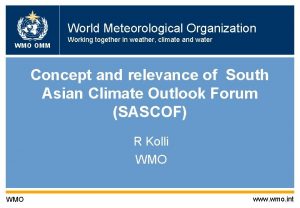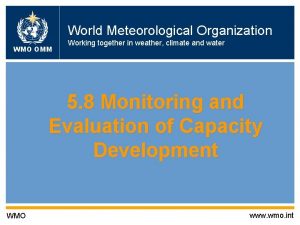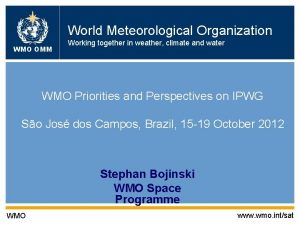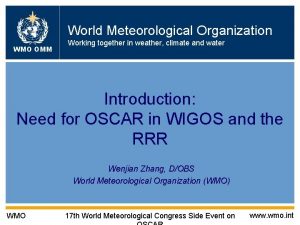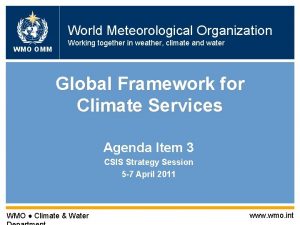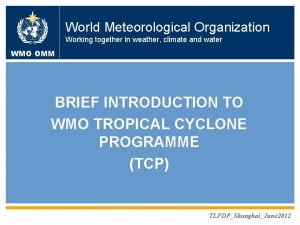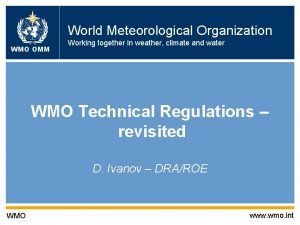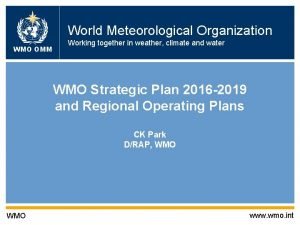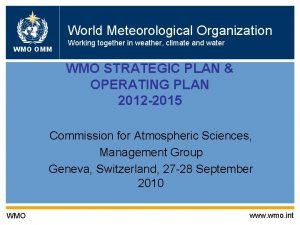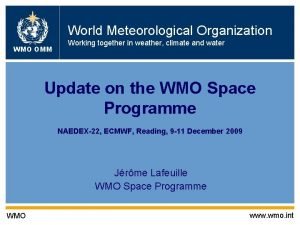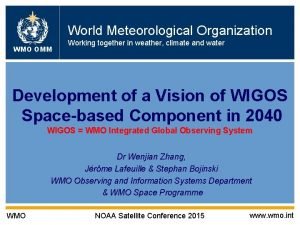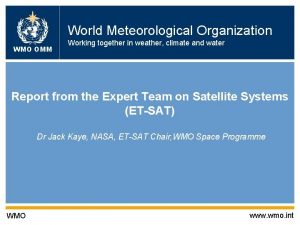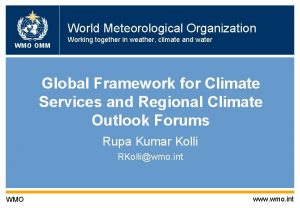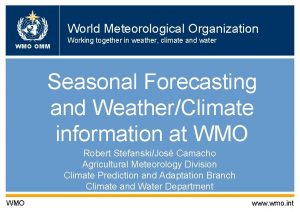World Meteorological Organization WMO OMM Working together in



















- Slides: 19

World Meteorological Organization WMO OMM Working together in weather, climate and water Wind Observations in the Global Observing System – a WMO Perspective ISS Winds Mission Science Workshop, Miami, Feb 10 -11 2011 Lars Peter Riishojgaard, Chair CBS OPAG-IOS and Jerome Lafeuille, Space-based Observing Systems Division, WMO Space Programme www. wmo. int

Outline WMO OMM • WMO, WWW and the GOS • The WMO Rolling Requirements Review – • • CBS, OPAG-IOS, Expert Teams, Workshops The current GOS – Mass and wind – Data impacts WMO Vision for the GOS in 2025 Miami, 2/10/11 ISS Winds Science Mission 2

WMO OMM WMO, WWW and the GOS • WMO: World Meteorological Organization; a specialized agency of the United Nations; the UN system's authoritative voice on meteorology, climatology, hydrology – WWW, World Weather Watch: Core WMO programme since 1963; observing systems, information systems and telecommunication facilities, and data-processing and forecasting centres; backbone for efficient meteorological and hydrological services, worldwide – Key WWW components: • GTS (Global Telecommunications System) evolving towards Miami, 2/10/11 ISS Winds Science Mission 3 WIS

WMO OMM WMO Global Observing System • Coordinated system of methods and facilities for making meteorological and other environmental observations on a global scale in support of all WMO Programs – – – Surface stations Upper-air network Marine observations Aircraft Satellite systems • Owned and operated by WMO member states on behalf of WMO; subject to WMO Regulatory Materials • WMO vets and documents requirements for the GOS through its Rolling Requirements Review Miami, 2/10/11 ISS Winds Science Mission 4

WMO OMM The Rolling Requirements Review (RRR) in the WMO structure • Commission for Basic Systems; one of eight WMO Technical Commissions. President: Fred Branski, NOAA/NWS –… – OPAG for the Integrated Observing System; one of four OPAGs under CBS. Chair: L. P. Riishojgaard, JCSDA • … • Expert Team on the Evolution of the Global Observing System; one of six Expert Teams under OPAG-IOS. Chair: John Eyre, Met Office – Requirements database (by application area) for Global NWP, Regional NWP, Nowcasting, Agrometeorology, etc. – Capabilities database (by observing system), e. g. RAOBS, GEO imagers, AMDAR, buoys, etc. – Gap analysis, Statements of Guidance – Implementation plan Miami, 2/10/11 – Vision for ISS the Winds Science Mission 5 GOS in 2025

WMO OMM RRR (I) • ET-EGOS – Meets once a year in Geneva – Oversees all requirements, all application areas through focal points – Interacts with other CBS Expert Teams, teams from other WMO Technical Commissions and co-sponsored programs (e. g. GCOS) • WMO Rapporteur on Scientific Evaluation of Impact Studies (formerly “Rapporteur on OSEs and OSSEs”) – Responsible for gathering community input specifically on NWP • WMO Workshop on the Impact of Various Observing Systems on NWP – Every four years, by invitation only, organized by Rapporteur on SEIS and OPAG-IOS – All major NWP Centers meet to compare impacts of all major elements of the GOS – OSEs and adjoint sensitivity Miami, 2/10/11 ISS Windsdiagnostics Science Mission 6

Impact of GOS components on 24 -h ECMWF Global Forecast skill (courtesy of Erik Andersson, ECMWF) Growing importance of research data Satellite data now account for most of the skill Slide 7

Impacts of Various Observing Systems in GEOS-5. 5. 1 Ron Gelaro, GMAO 24 -hr Forecasts from 00 z Analyses on 28 Jan – 02 March 2010 Adjoint-Based Global Forecast Error Measure Impact Per Observation Total Impact RAOBs continue to be important for some systems Forecast Error Reduction (1 e-6 J/kg) Forecast Error Reduction (J/kg) Improves Forecast Degrades Forecast Observation Count Fraction of Beneficial Observations Miami, 2/10/11 ISS Winds Science Mission Science Workshop 8

Importance of Satellite Data in NWP http: //www. nrlmry. navy. mil/obsens/ Satellite Data has become the single most important component of the global observing network for NWP Observation Impact all 2 1 1 6 Different satellite data important for different systems Miami, 2/10/11 Σ Sat Winds = -198. 3 ISS Winds Science 9 Mission Science Σ Sat Radiances = -143. 9 Σ Conv = -168. 0

500 h. Pa anomaly correlation coefficients, NH w 4 -9 w 0 -3 Miami, 2/10/11 w 10 -20 10

500 h. Pa anomaly correlation coefficients, SH w 4 -9 w 0 -3 Miami, 2/10/11 w 10 -20 11

WMO OMM 4 th WMO Impact Workshop (Geneva, May 2008) An additional 2 to 6 hours of useful forecast range is the most any individual component of the GOS can contribute in the NH Overall impact (“marginal skill”) on short/medium range global NWP This is very significant in terms of socioeconomic impact and is strongly linked to other measures of skill! Miami, 2/10/11 ISS Winds Science Mission 12

WMO OMM RRR (II) • ET-EGOS consolidates input on Requirements from all sources into output documents – e. g. Vision, Implementation Plan • Routing: – ET-EGOS OPAG-IOS CBS WMO EC • Once adopted by the WMO Executive Council, the material becomes official WMO document Miami, 2/10/11 ISS Winds Science Mission 13

GOS and Numerical Weather Prediction WMO OMM • Numerical weather prediction requires independent and global observations of the mass (temperature) and wind fields • The global three-dimensional mass field is well observed from space • No existing space-based observing system provides vertically resolved wind information => horizontal coverage of wind profiles is sparse • The lack of wind measurements is widely believed to be one of the main limiting factors for progress in NWP skill at all temporal ranges – Especially critical as we progress to smaller and smaller scales where wind/mass balance assumptions break down Miami, 2/10/11 ISS Winds Science Mission 14

WMO OMM Current Upper Air Mass & Wind Data Coverage Vertically resolved Mass Observations Miami, 2/10/11 Vertically resolved Wind Observations ISS Winds Science Mission 15

WMO OMM Elements of the long-term vision for the Global Observing System • Vision for the GOS in 2025 endorsed by WMO Executive Council on 11/06/09 – Provides high-level guidance for global observation planning – Framework for WMO Members to commit on contributing missions • Calls for major enhancement of the space component – Geostationary, polar-orbit and other orbits as appropriate – Transition of several missions from R&D to operational/sustained status (Altimetry, GPS radio-occultation, scatterometry, Miami, 2/10/11 ISS Winds Science Mission 16 chemistry)

Vision for the GOS in 2025 (space component) Summary of missions called for on operational basis Core operational GEO missions WMO OMM § § § All with IR hyperspectral sounding, lightning detection Core operational LEO Imagery and IR-MW sounding § All with hyperspectral IR, on 3 sun-synchronous orbital planes § § § § Ocean surface topography Radio-Occultation Sounding Ocean Surface Wind Global Precipitation Earth Radiation Budget Atmospheric Composition Special imaging for ocean colour, vegetation Dual-angle view IR imagery Observations performed so far on a R&D basis should be planned on an operational or sustained basis Integrating new § Land Surface Imaging missions § Synthetic Aperture Radar §Miami, Space Weather instruments 2/10/11 ISS Winds Science Mission 17

WMO OMM Vision for the space-based GOS in 2025 Operational pathfinders and demonstrators Doppler wind lidar on LEO Winds; aerosol; cloud-top height [and base] Low-frequency MW radiometer on LEO Ocean surface salinity; soil moisture MW imager/sounder on GEO Precipitation; cloud water/ice; atmospheric humidity and temperature High-resolution, multi-spectral narrow-band Vis/NIR and CCD imagers on GEOs Ocean colour, cloud studies and disaster monitoring Vis/IR imagers on satellites in high inclination, Highly Elliptical Orbits HEO) Winds and clouds at high latitudes; sea ice; high latitude volcanic ash plumes; snow cover; vegetation fires Gravimetric sensors Miami, 2/10/11 ISS Winds Science. Water Missionvolume in lakes, rivers, 18

WMO OMM Summary • As of June 2009, space-based wind lidars are part of the official WMO Vision for the Global Observing System 2025 – This means that the National Meteorogical and Hydrological Services of the WMO member states have signed off on this as something that can and should be done! • WMO does not own or implement satellite systems – However, WMO does set standards for taking, processing, disseminating and exchanging observations Miami, 2/10/11 ISS Winds Science Mission 19 – WMO also captures and documents requirements
 Wmo omm
Wmo omm Wmo omm
Wmo omm Wmo omm
Wmo omm Wmo omm
Wmo omm Wmo omm
Wmo omm March 23 world meteorological day
March 23 world meteorological day Viscerosomatic reflex
Viscerosomatic reflex Omm vs chiropractic
Omm vs chiropractic Omm physical exam
Omm physical exam Omm theme
Omm theme Vott a passa
Vott a passa Hard work vs smart work presentation
Hard work vs smart work presentation Hot working vs cold working
Hot working vs cold working Hot working and cold working difference
Hot working and cold working difference Machining operations
Machining operations Pengerjaan panas dan dingin
Pengerjaan panas dan dingin Working together to safeguard children’ 2018 summary
Working together to safeguard children’ 2018 summary Teamwork animals working together
Teamwork animals working together Udai working together works
Udai working together works Jan nigro poem teamwork
Jan nigro poem teamwork
